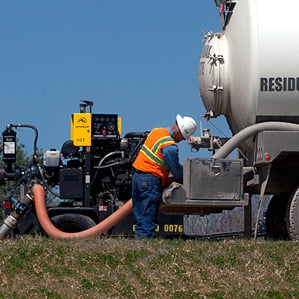Skipping the Water in Fracking
Hydraulic fracturing, or fracking, uses large amounts of water injected into wells under high pressure to help free natural gas and oil from shale deposits (see “Drilling for Shale Gas”). Yet some of the world’s largest sources of shale gas are found in deserts, making the technique seem impractical.

It’s possible to fracture gas-rich rock formations without using any water at all. Indeed, gas and oil companies have been using carbon dioxide this way for decades, albeit on a limited basis. But if this approach is going to be used on a large scale, it will require a major investment in infrastructure for getting carbon dioxide to fracking sites. And in some cases a price on carbon emissions may be the only way to make the economics work.
In the United States, the abundant natural gas made available by fracking has spurred a huge shift to this fuel from coal, reducing greenhouse-gas emissions from power plants (see “Natural Gas Changes the Energy Map”). But shale gas is also plentiful in places such as China, which is estimated to have 50 percent more of this resource than the United States.
Right now carbon dioxide fracking is used in places, like Wyoming, that already have carbon dioxide pipelines. Economics alone could justify building more in some places, says Robert Dilmore, a research engineer at the U.S. National Energy Technology Laboratory.
In other cases building pipelines might require a push from governments. A price on carbon, for example, could create a big supply of cheap carbon dioxide by giving utilities incentive to capture it from power plants’ smokestacks. This might make sense in China, where the best shale gas deposits are in arid areas (see “China Has Plenty of Shale Gas, but It Will Be Hard to Mine”). One of the largest shale gas resources in the world is the Tarim Basin in northeast China, located beneath the Taklamakan Desert—one of the largest sandy deserts in the world, with nearly 300,000 square kilometers of shifting dunes. Piping in water would strain already tight supplies. But these days, as China quickly adds to its stock of coal-fired power plants, the country has plenty of carbon dioxide—it’s just not capturing and using it.
Fracking with carbon dioxide has a number of potential advantages. Not only would it eliminate the need for millions of gallons of water per well, it would also eliminate the large amounts of wastewater produced in the process (see “Studies Link Earthquakes to Wastewater from Fracking”).
Water-free fracking could also solve other problems. In conventional fracking, half the water pumped into a well flows back to the surface, but the other half stays in the rock formation. The water that’s left behind can block the path of the natural gas, slowing down production and possibly decreasing the total amount a well can produce over its lifetime, Dilmore says.
When carbon dioxide is used instead of water, most of it comes back out of the well (where it can be captured and used again). This in turn allows natural gas to flow out more freely. Some recent research suggests that using carbon dioxide can also result in a better network of fractures, making it easier to extract the fuel. And once infrastructure is in place to deliver carbon dioxide, it can be used to enhance production later in the life of a well. In any shale gas deposit, a large fraction of the natural gas sticks to the shale rather than flowing out. But carbon dioxide has a greater affinity for the shale than natural gas does, so it can be used to displace the fuel and free it from the rock.
After the well is done producing, it can be sealed up, storing the carbon dioxide permanently underground. That would help reduce greenhouse-gas levels in the atmosphere.
To be sure, carbon dioxide fracking poses many challenges besides the lack of infrastructure. Unlike water, gases are compressible, so it’s more difficult to reach the pressures needed to fracture the rock. Also, the carbon dioxide has to be separated from the natural gas before shipping the fuel to market, which adds to costs. And it will probably never be economical to install carbon dioxide pipelines all the way to every fracking well. Trucks will be needed to convey the carbon dioxide the last mile—more trucks than would be needed with water fracking. That could increase local noise, pollution, and road damage.
In some places, especially where water is relatively abundant, there may never be a compelling reason to switch. Grant Bromhal, another research engineer at NETL, says he expects water-based fracking will continue to dominate, but that could change if carbon dioxide’s advantages become overwhelming. “My crystal ball isn’t clear enough,” he says. “There’s still a lot to be learned about these shale formations.”
Keep Reading
Most Popular
How scientists traced a mysterious covid case back to six toilets
When wastewater surveillance turns into a hunt for a single infected individual, the ethics get tricky.
The problem with plug-in hybrids? Their drivers.
Plug-in hybrids are often sold as a transition to EVs, but new data from Europe shows we’re still underestimating the emissions they produce.
What’s next for generative video
OpenAI's Sora has raised the bar for AI moviemaking. Here are four things to bear in mind as we wrap our heads around what's coming.
Stay connected
Get the latest updates from
MIT Technology Review
Discover special offers, top stories, upcoming events, and more.